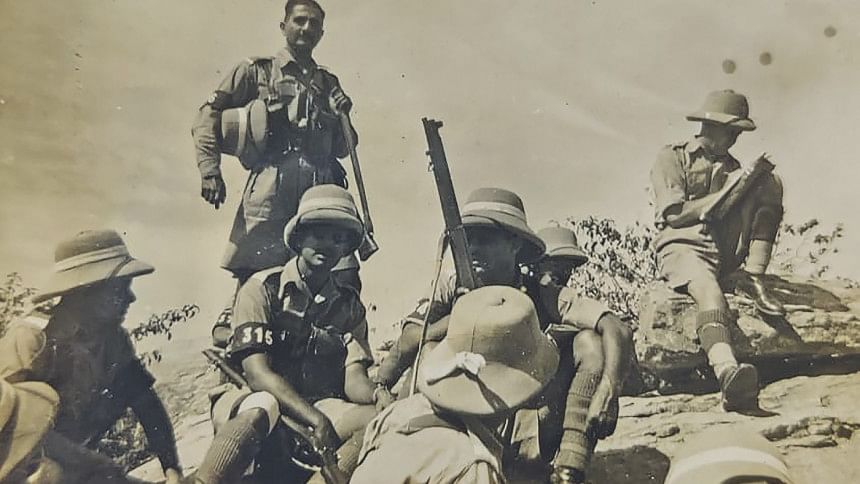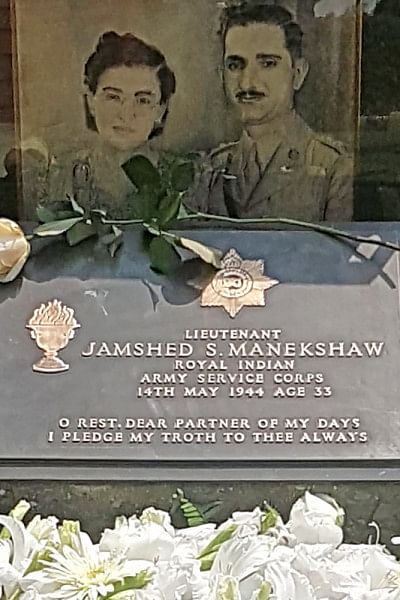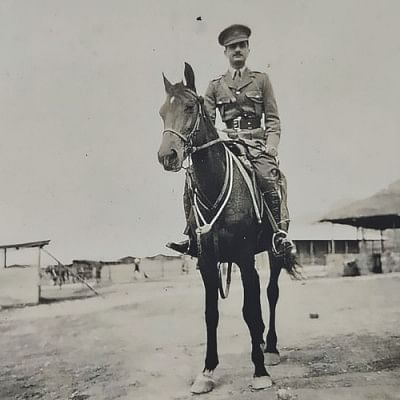Lt Jamshed Manekshaw: An unsung hero of World War II

The world knows late Field Marshal Sam Manekshaw as the man who, as the chief of the Indian army in the 1971 Indo-Pakistan War following the Bangladesh Liberation War, made great contributions to the creation of Bangladesh. Sam also fought on the Burma front as a Captain of the 12th Frontier Force and was seriously wounded fighting the Imperial Japanese Army during World War II. But the world is unaware that another Manekshaw --Lt Jamshed Manekshaw (Jimmy)--was also defending the Indian territory against the Japanese invasion in the Dohazari region of the Chittagong front during World War II. While Sam survived the bullet wounds, Jamshed died in action in Dohazari and he became an unsung martyr. Lt Jamshed Manekshaw died on May 14, 1944.

Lt Jamshed belonged to Bulsar in Gujarat state of undivided India and he worked in Kabul in Afghanistan before he joined the Indian army as a commissioned officer. He was sent to fight against the Japanese Imperial forces in the northeast part of India and in the Chittagong's areas. These areas which were then part of the erstwhile East Bengal are now part of Bangladesh. A large number of Indians, British, Australian and Africans died in action fighting here. Based on their religion the last rites of these brave soldiers were performed in the various war cemeteries built by the British army in the region. They were designated military cemeteries where the martyrs were laid to rest with full military honours. Lt Jamshed Manekshaw belonged to the Parsi community in India; the Parsis are Zoroastrians who fled from Iran to settle down in India. The Parsis who settled down in Gujarat after escaping from Iran facing persecution later spread to various parts of India and excelled in business. They contributed to the economy of undivided India and a few families had businesses in Dhaka and Chittagong too. There was one businessman, Mr Merdhora, who lived in Chittagong then and the British took his help in performing the last rites of Lt Jamshed.

It is believed that his last rites were performed according to the Parsi religion. There were originally 400 burials in these cemeteries and later when the Commonwealth War cemetery was built in Chittagong the graves were transferred to the new cemetery. There are now 731 Commonwealth graves of the 1939-45 war here, 17 of which are unidentified. This cemetery is maintained by the Commonwealth War Graves Commission of Britain that funds it.
The Commonwealth war cemetery is situated on the Badsha Meah Road in Chittagong city. The site of the cemetery was originally a paddy field adjacent to a horseshoe-shaped hill spread on the east and south, and located two and a half miles away from the then Chittagong city.
During the Second World War the pioneer camp of the Fourteenth Army of the allied force was set up in Chittagong along with facilities for army training and the British General Hospital. The hospital remained operative from December 1944 to October 1945 and initially, 400 corpses were buried in this cemetery under the supervision of the army.
The burial area is situated at the bottom of a slope directly behind Finlay's Guest Houses and is surrounded by a large area planted with a mixture of jungle trees, fruit trees and flowering trees. It is not easily seen from the road.
I am a regular visitor to Dhaka in connection with the Moyeen Foundation Jaipur Foot artificial limb fitment camp and I come as a team leader. When the camp was being organised in 2017, Salahuddin Ahamad, a former Indian bureaucrat who served as the Chief Secretary of the Rajasthan government and who is the Executive President of the Jaipur, India based Bhagwan Mahaveer Viklang Sahayata Samiti (BMVSS), the parent body of the world-famous Jaipur Foot. Salahuddin has a great passion for cemeteries and apart from the various Indian cemeteries, he travelled to see the cemeteries in Myanmar and in Egypt. He goes to pay homage to the great warriors there.
When he came to Dhaka, he and his friend from Bengaluru in India, Kalyan Ganguli whose ancestors were from Dhaka, drove to Chittagong to see the cemetery and I accompanied them. We all landed in the cemetery in the morning and were really impressed with the way the cemetery was maintained, with rows of plaques. The plaques bore the names of the soldier, his unit name and the year when he died. Each plaque had the religious sign to which the soldier belonged like a cross for the Christian and a temple sign for the Hindu. As we were seeing each plaque, I suddenly noticed the only plaque with a Zoroastrian (Parsi) signage in a row. I was fascinated and I leaned down to read the plaque and to my surprise, I found that the only Parsi who was laid to rest here was Lt Jamshed Manekshaw. The inscription read…Lieutenant Jamshed S Manekshaw, Royal Indian Army Service Corps,14th May 1944 Age 33, O Rest, Dear Partner of My Days I Pledge My Troth To Thee Always….

I called Salahuddin and Kalyan Ganguli to have a close look at the plaque. They came and read the inscription thereon and were equally surprised. It reminded us of Field Marshall Sam Manekshaw as he was the only known Manekshaw soldier and we never heard of another Manekshaw soldier. This Manekshaw was an unsung martyr about whom we never ever heard.
After each of us took pictures of this and other plaques, I thought I must send the picture of the plaque to the family members of late Jimmy Manekshaw. We had no clue before this how and we searched for his family. Salahuddin contacted his friend Brig Dara Gowadia, who was also a Parsi; he made frantic efforts to know about Jimmy's family, but could not find anything. Through Facebook, I sent messages to all the Manekshaws with the picture of the plaque with a request to connect with the family. Similarly, Salahuddin also tried all his contacts but without any success. I contacted my friend Farokh Manekshaw, who runs a resort in Goa to help me. After several months, he sent me a message that he had been able to find the son of Jimmy Manekshaw. He turned out to be Nauzer Manekshaw, a retired assistant commissioner of police. He did not believe his ears that we have been able to find the cemetery where his father was finally laid to rest.

"I was barely 15 months old when I lost my father, I don't remember his face or how he looked. His death brought us miseries as we lost the breadwinner of the family. My mother Zarine was shattered as I was still a toddler and our full life was before us. The army general sent my mother a letter announcing the death of my father. Then we were in Bulsar. My mother moved to Hoshangabad town in India and spent some time there; my mother with great difficulty was trying to raise me. She got a job in Nashik in a school where she taught art. She was a good painter and this skill helped her get a job as a teacher. By then in the forties, the British sanction Rs 100 pension to my mother and Rs 300 per month pension as a minor to me. After schooling, I completed my college education and graduated from Nashik. But I always missed my father. When my father was laid to rest in Dohazari , 45 km from Chittagong the Dohazari cemetery was built. I am 76 years old now, then I was five years old when I came with my mother to Dohazari to place a wreath on the war memorial that was raised there and the plaque carried a message of my mother Zarine. I have a faint memory of this visit to Dohazari, but I still remember, how my mother cried to see my father's grave. But I was clueless as to why she was sobbing. My mother drew a painting of my father and my mother with charcoal. This sketch was inspired by a picture of my father in uniform with my mother taken in a studio. I still have the picture. It is the only picture of my father and my mother. I have been seeing this picture even today," shared Nauzer.
Nauzer had no clue that the mortal remains of his father was shifted along with others to the new Commonwealth War Cemetery in Chittagong until I informed him.

"When you and Salahuddin Saheb informed me about this new cemetery in Chittagong I decided to go there and I decided to take my whole family to Chittagong and we booked our tickets and our hotel to pay homage to my father. I wanted my sons and grandchildren to know the final place of rest of my father. I wish my mother was alive. My mother lived with me after I joined the Bombay police until her death. She was a sad woman but she brought me up very well. I served the Mumbai police and served as an honest police officer and retired as assistant commissioner of police. I am still active as a security adviser."
Nauzer flew to Chittagong with his three sons Jimmy, Rumi and Sam, the third son Sam was named after Field Marshall Manekshaw, the hero of India-Pakistan War who effected the surrender of the Pakistan army in Bangladesh after that the nation Bangladesh was born. "Thus, I have very happy connections with Bangladesh," said a nostalgic Nauzer.
Nauzer along with his three sons and daughters-in-law, two granddaughters and two grandsons all were there at the Chittagong cemetery along with me as I guided them to the father Jimmy Manekshaw's memorial.
The ceremony was well-organised at Chittagong where a specially-made wreath with white roses and white lilies were placed on the plaque and a lamp lit. Nauzer's eyes were moist when he placed a photo frame of the charcoal painting of his parent drawn by his mother on the rear side of the plaque. The family joined in prayers. It was a touching moment. For Nauzer, it was a dream fulfilled and his sons, grandchildren and daughters-in-law visited the site for the next two days to pay homage.
"I shall cherish all my life these moments and the time spent at the Chittagong cemetery. For me this is not a cemetery but a pilgrimage. I salute my father," said Nauzer.
Prakash Bhandari is a veteran Indian journalist, formerly with The Times of India.

 For all latest news, follow The Daily Star's Google News channel.
For all latest news, follow The Daily Star's Google News channel. 



Comments